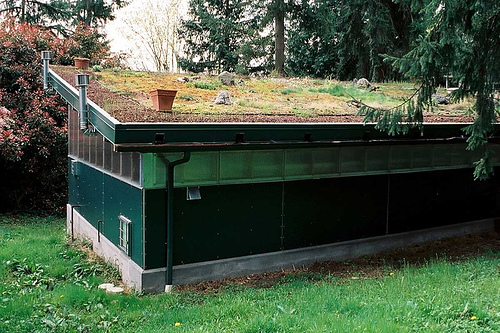 Rooftop gardens, or green roofs, are popping up everywhere. These gardens add life and color to gloomy, industrial looking cities and drab roofs.
Rooftop gardens, or green roofs, are popping up everywhere. These gardens add life and color to gloomy, industrial looking cities and drab roofs.
Rooftop gardens improve air quality, create local food sources, delay water runoff, and bring color to a dull roof. They also help insulate buildings and reduce electricity and gas costs, which is particularly beneficial for people who live in very hot or cold areas. According to GreenRoofs.com, green roofs allow buildings to retain 30% more heat in the winter than ordinary roofs. Green roofs also reflect light and heat, which may help buildings stay cooler in the summer. The insulation from rooftop gardens also helps block out noises from outside.
There are many different kinds of green roofs, but they are all essentially built in the same way. Several layers are needed to plant a rooftop garden:
- Waterproof layer – This is the base layer. It’s added directly to the roof to make sure that water from the garden won’t leak onto the actual roof.
- Roof membrane – The roof membrane is a pond/butyl lining. It is laid on top of the waterproof layer. Ideally, it should be laid as one continuous sheet of material. If this isn’t possible, you can overlap sheets by twenty centimeters.
- Filter sheet – The filter sheet is laid down after the roof membrane. It lets moisture drain off the rooftop.
- Moisture blanket – The moisture blanket is placed down next. It helps the growing medium retain just the right amount of moisture for plants to thrive. If you want to cut costs, you can use cardboard or an old blanket as your moisture blanket.
- Soils, seeds, and plants – This is the last layer. It is the growing medium, and it should be light and nice. Find out what grows well in your area, and plant what you like. If you live in a sunny area, you may want to plant hearty bushes and shrubs, fruit trees, junipers, and grasses. If your roof is slightly sheltered, you probably shouldn’t plant top heavy, tall-stemmed flowers like peonies or lilies. Plants that do not require very much watering like moss, ferns, sedum, and sempervivum do well on most rooftops.
If the thought of setting up your own rooftop garden intimidates you, there are many professionals who specialize in rooftop garden installation, and they can be a huge help. Also, you don’t have to completely cover the whole surface of your roof with a garden. “Container gardens” are available to cover portions of your roof, and they are easy to install and cost-effective.
Make your life a tad bit greener by installing a rooftop garden! Whether you live in a suburban area or a big city, a green roof will transform your house and city for the better.
